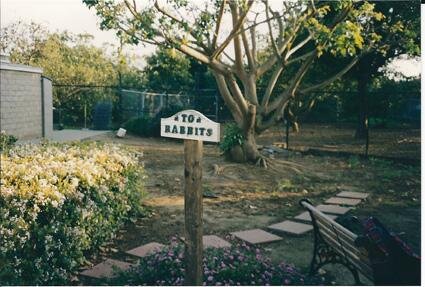|
Twenty-five Years of BUNS: The Beginning
By Jean Silva
In 1992, Dorothy Diehl was looking for an Angora rabbit. She came to the County Animal Shelter in Goleta. She didn't find an Angora. What she found was several sad looking rabbits sitting outdoors, on the ground in wire cages. The cages were too small for comfort. Their food and water bowls were over turned and empty.
That night Dorothy was unable to sleep. The next day she drove to the shelter from her home in Carpinteria. Dorothy brought food and water bowls, filled them and attached them to the cage walls so they could not be tipped over. Every day after that, Dorothy came to the shelter to give the rabbits food and water. Each Saturday, Dorothy spent the day at the shelter with the bunnies. She greeted each visitor and asked if they could volunteer to help the bunnies. Gradually she recruited volunteers. That was how BUNS began.
We became BUNS volunteers because my husband Phil and I read the charming book Watership Down. We wanted a bunny. Our first rabbit, Fang, came from a pet store. When our friends found out that we had a bunny they asked us to take more. One neighbor brought us a bunny, Mopsy, who was being mugged by other bunnies at a ranch. A landscaper, brought us a family of rabbits trapped on an estate. “The owners want them gone or poisoned.” she explained. Another group of rabbits had been abandoned on a farm; the farmer threatened to feed them to his pigs. Soon we had too many bunnies and gave some to other friends.
One day, a friend called to say that her rabbit had gotten out of her yard. Since I gave her the rabbit, she wanted me to tell her what to do. I had no idea. But I went to the Santa Barbara County Animal Shelter the next Saturday to ask them.
When I was at the shelter, the staff asked if I wanted to see the rabbits. So I followed directions and found the rabbit area. Dorothy Diehl was there and we started talking. Dorothy said that they needed volunteers and could use experienced rabbit people. Well, I was feeling pretty ignorant about rabbits, but decided to ask Phil. He said yes. That was how we became BUNS Sunday volunteers. At last Dorothy had a volunteer for every day of the week.
When we started, BUNS had a few hutches clustered for shade under Flame trees. One hutch was filled with rabbit pellets and hay. Volunteers cleaned the cages, changed litter boxes, fed and watered all the bunnies. At that time there were only five or six bunnies. Their care did not take much time. I remember, one volunteer, Nancy, spent her lunch hour, one day a week, cleaning and feeding. Most of the time the rabbits were caged and unsupervised. Dorothy came spent every Saturday talking to visitors hoping to adopt rabbits.
Dorothy and her partner, Tom, had plans. With their leadership we found some abandoned panels to build an exercise pen. The Dog Adoption Welfare Group (DAWG) included BUNS under their non profit status, so we could raise money for more improvements. We wanted a building so the rabbits could be inside.
Stay tuned next month for more about BUNS early years! Be sure to subscribe to our newsletter so you don't miss the February edition of The Carrot Tribune!

Read More
|